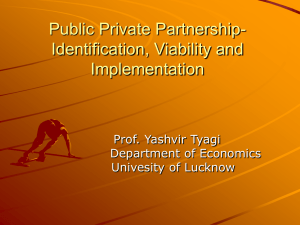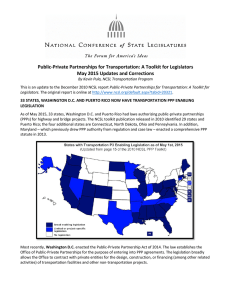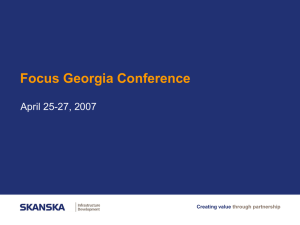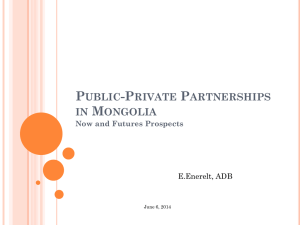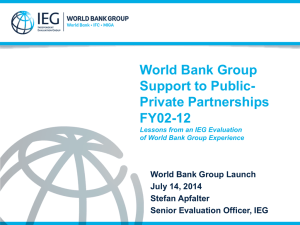Reed - NCPPP
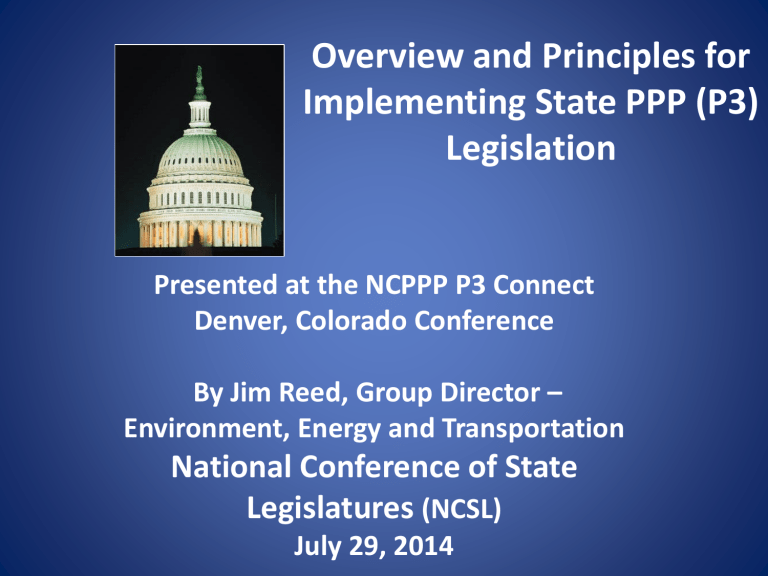
Overview and Principles for
Implementing State PPP (P3)
Legislation
Presented at the NCPPP P3 Connect
Denver, Colorado Conference
By Jim Reed, Group Director –
Environment, Energy and Transportation
National Conference of State
Legislatures (NCSL)
July 29, 2014
Backdrop:
Government Funding Shortfalls
• Great Recession aftermath, slow growth
• Climbing out of State budget shortfalls since 2008
• Political reluctance to raise new taxes
• Previous underinvestment in infrastructure
• Aging infrastructure in all sectors
• Continuing uncertainty of federal funding and program, less federal funding going forward, i.e.
HTF
• Transportation: Declining gas tax revenues (less driving, electric and hybrid vehicles, millennial’s drive less)
The P3 Option
• Public-Private Partnerships are attractive because they:
• Can complete projects that cannot be fully funded through traditional means.
• Expand the pool of available money for transportation projects- private equity.
• Can create cost savings in terms of lower initial project cost to the public, quicker project completion and longterm operation & maintenance
• Private sector takes on a portion of the financing risk and other risks.
• Bring private sector practices and innovations into public projects, which can increase efficiency.
Two Key Legislative Factors That Assist
States in Developing P3s
• Robust and Comprehensive PPP Enabling
Legislation: Sets up the institutional framework within which PPPs can occur
– “PPP enabling laws are important in facilitating private investment in infrastructure. Better designed PPP enabling laws can serve to attract more private investment into a state.”
(Geddes and Wagner ,Cornell Univ. study using linear probability models to examine P3 laws - August 2012)
• Creating enhanced public sector expertise by establishing a specialized P3 office
33 States with Transportation PPP Enabling
Legislation + Puerto Rico
Key Elements: PPP Enabling Legislation
• Gives broad authority for a variety of P3 projects
• Creates a robust framework for contracting
– Flexibility in application of state procurement laws
• Defines allocation of risks between public sector and private partners
• Allows combination of private and public money in financing, also allows revenue sharing
• Allows availability payments
• Political approval at an appropriate (early) stage
• Creates specialty P3 office to handle projects
Closing the Expertise Gap:
State PPP Offices
• Arizona Office of P3 Initiatives (DOT)
• California Public Infrastructure Advisory Commission (BTH)
• Colorado High Performance Transportation Enterprise (DOT)
(Government-owned business)
• Georgia P3 Program (DOT)
• Michigan Office for PPPs (Treasury Dept)
• Ohio Division of Innovative Delivery (DOT)
• Oregon Office of Innovative Partnerships and Alt. Funding (DOT)
• Puerto Rico Public-Private Partnerships Authority
• Texas Best Practices Center (under development)
• Washington Transportation Partnerships Office (DOT)
• Virginia Office of Transportation PPPs (DOT)
• Proposed Federal Center of Innovative Transportation Finance
NCSL PPP Principles
• Principle 1: Be informed.
Decision makers need access to fact-based information that supports sound decisions.
• Principle 2: Separate the debates.
Debates about the PPP approach should be conceptually distinct from issues such as tolling, taxes or specific deals.
• Principle 3: Consider the public interest for all stakeholders.
Legislators should consider how to protect the public interest throughout the PPP process.
NCSL PPP Principles
• Principle 4: Involve and educate stakeholders.
Stakeholder involvement –early and often--helps protect the public interest, improve buy-in and mitigate political ris k.
• Principle 5: Take a long-term perspective because
P3s are long-term
.
Legislators should approach PPP decisions with the long-term impacts in mind, looking beyond short-term considerations
• Principle 6: Let the transportation program drive
PPP projects—not the other way around.
PPPs should be pursued to support a state’s transportation strategy, not just to raise short-term revenue.
NCSL PPP Principles
• Principle 7: Support comprehensive project analyses.
Before pursuing a PPP, it should be shown to be a better option than traditional project delivery.
• Principle 8: Be clear and transparent about the financial issues.
States must carefully assess financial goals, an asset’s value and how to spend any proceeds.
• Principle 9: Set good ground rules for bidding and negotiations.
Legislation should promote fairness, clarity and transparency in the procurement process.
NCSL Contact Information
Jim Reed
Group Director – Environment, Energy and
Transportation
Denver, Colorado
(303) 856-1510 jim.reed@ncsl.org



